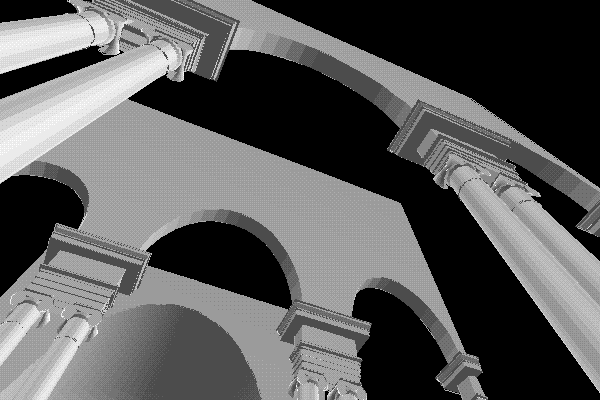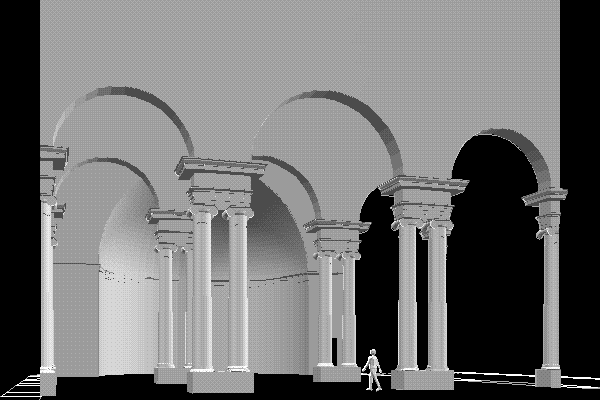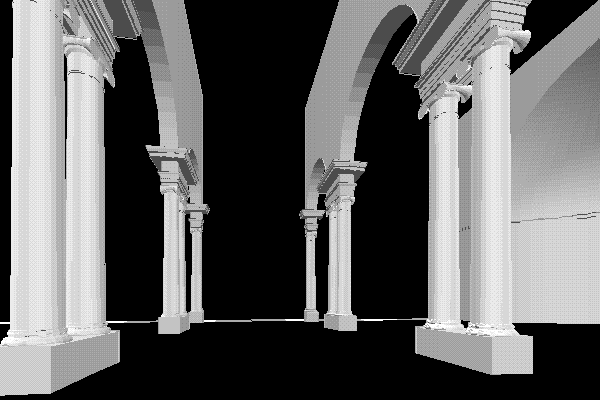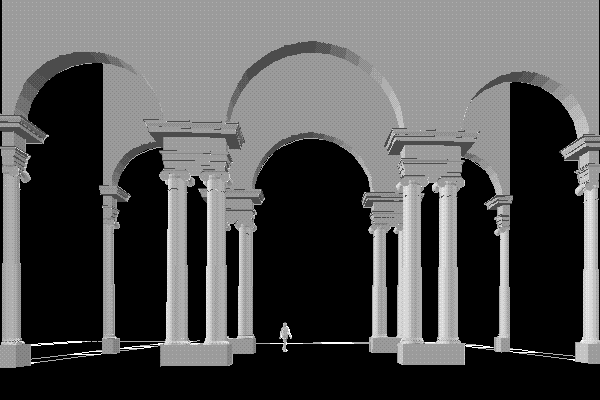
Images derived from a 3d computer model of the Basilica Hierusalem, the original Santa Croce in Gerusalemme are now available at... The model is based on a plan of the basilica as featured in the Corpus basilicarum Christianarum Romae, and on a schematic reconstruction featured in Krautheimer's Early Christian and Byzantine Architecture.
You will note that I have dated the Basilica Hierusalem as circa late 326. This indicates my contention that the basilica came into being after Helena's death (circa 1 August 326), and that the basilica was constructed (perhaps under the guidance of Eutropia) to both honor Helena as well as the relics she (Helena) had just brought to Rome. This thinking coincides with what happened at the "the house of Crispus" in Trier after his murder/death. The Imperial house at Trier was demolished, and an enormous double basilica was erected in its place (and there are still today two churches at Trier on the double basilica site).
In terms of design, the double columns of the Basilica Hierusalem seem to have been "reenacted" at the mausoleum of Constantina (today's Santa Costanza, Rome). Constantina was one of the daughters of Constantine, and the grand-daughter of both Helena and Eutropia. Continuing with the double theme, the typology of double basilicas in Christian architecture is extremely rare, and those that exist(ed) appear to have been first constructed within the decade or so before and after 326.
| |



| |
"Constantine's Mother's House"
"The Chronosomatic Letters"
"One Very Piranesian Daze"
"Inside the coming apart-at-the seamless envelop"
"Collecting Relics "
"6+ Lamps of Architecture"
Since c.1500, humanity (however, mostly Western/European culture) has operated predominantly under the influence of an assimilating imagination--a process whereby everything about this planet, and even beyond, has been and still is run through the workings of absorption -- absorption of land, data, capital, whole societies, etc. (Science in general is a very assimilating process, and genocide is just one example of absorption in the extreme--purge.)
According to chronosomatics, a theory based on the interrelationship of time and the human body, there are roughly 200 years left where assimilation will play a major role with regard to the human imagination, and, more importantly, the next 200 years of assimilation will also be the largest and grossest "chunks" of assimilation yet, perhaps culminating with the total and complete knowledge of every bit of rhyme, reason, cause and effect of the human genome. Chronosomatics also shows us that metabolism (equal doses of creation and destruction) has been steadily becoming the new and eventually predominate operation of the human imagination. Therefore there is a strong pluralism within the operation of the human imagination today as well.
Are there thus some things within the last 500 years architectural history that relate to the notion of an assimilating architecture? Is there something about the present state of architectural affairs that points to an assimilating and/or metabolic architecture? For example, is the high eclecticism of the late 19th century one form of assimilating architecture? Is Le Corbusier's Purism akin to assimilating architecture in the extreme? Is the current widespread/global land development precisely a continuation of the assimilating process begun by the likes of Christopher Columbus? Will humanity, 200 years hence, have come extremely close to assimilating (for better or for worse) every square inch of this planet?
Personally, I think the answer is yes, but that's not the worst of it. After assimilation ceases to be a major element within the operation of the human imagination, humanity will spend 500 years working under the influence of an almost purely metabolic imagination. Imagine living on Earth when pretty much everything thought and done is create and destroy, create and destroy, create and destroy. . . . .
Our present time... ...there is an active mixture of assimilation and metabolism. In about 200 years assimilation ends, hence the beginning of 100% metabolism, which will last for about 500 years. Around 2700 AD the diaphragm and the lungs enter the picture and this marks the beginning of a 300 year transition from metabolism to osmosis.
Around 3090 AD metabolism will be over and osmosis will be 100% except for the sudden appearance of the heart. At this time there will also have already occurred the second birth. The lungs and the heart are working in unison, and are the only organs in operation (in the "plane of the present") for over 500 years.
...the breasts with the function of nurturing.
After the era of the heart, there is still a long period of the lungs... Just the question of what it will be like after the heart is baffling. ...100% osmosis, but there will also be a much more articulated bone structure in place.
...as it is leaving the lungs, the present is also starting to slice through the out-stretched arms. ...the outstretched arms are where mankind will achieve his greatest reach. ...it is interesting that the arms are only bones and muscles, and no organs. This morphology makes the arms very similar to the legs, even to the extent that the biceps are like the thighs, the elbows are like the knees, the forearms are like the calves, the hands are like the feet and the fingers are like the toes. There is this inverse, rotated symmetry.
...something significant about the pervasive symmetry that reaches its extreme manifestation in the arms, but started with the (symmetry of the) lungs and rib cage. This reverse symmetry between the legs and the arms also makes me wonder about the nature of Time and whether Time is somehow effected by this reverse symmetry.
Perhaps what is also significant about the era of the outstretched arms is its relative short time span (especially when compared with the long time span of the legs). As a guess, the time span is something like 500 years.
...the neck, the narrowest cross-section in the body. The move of the present from the outstretched arms to the neck presents contrast and transition at its most extreme.
|



